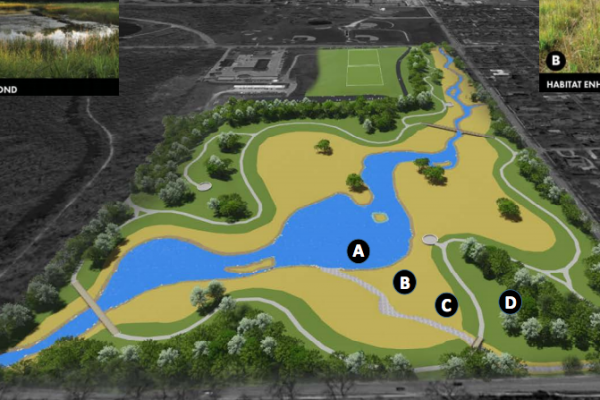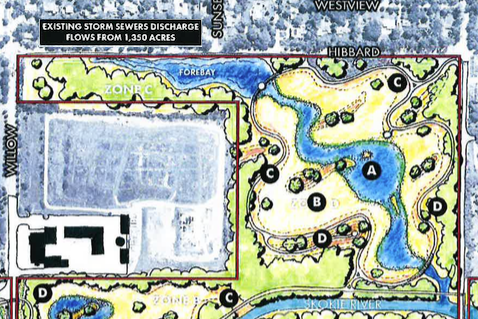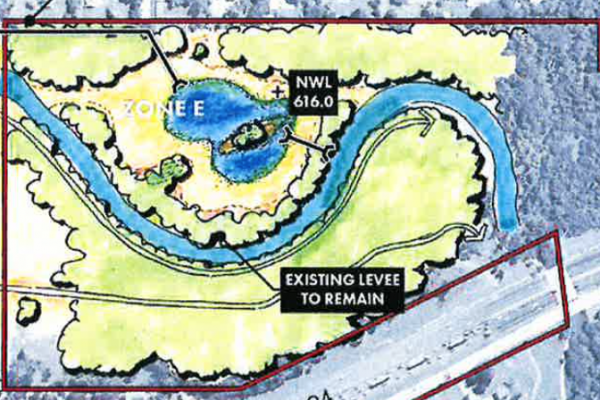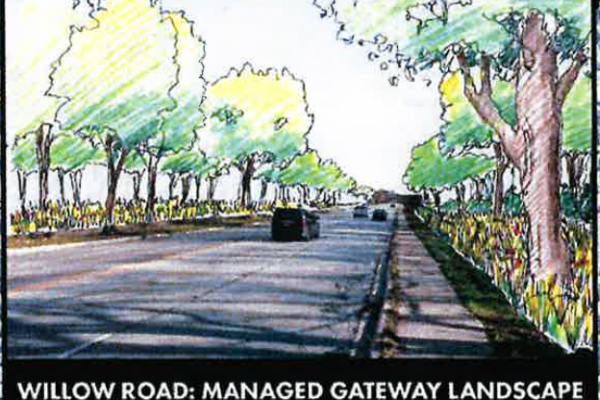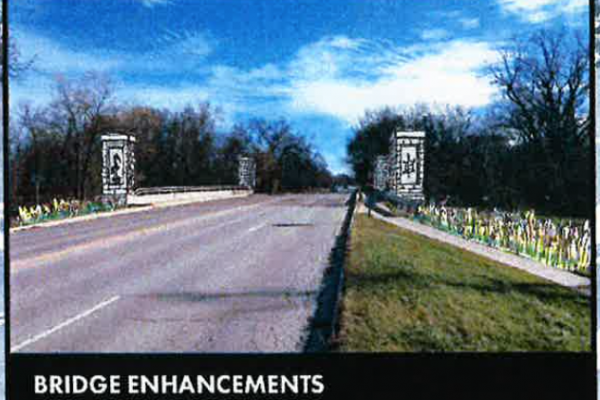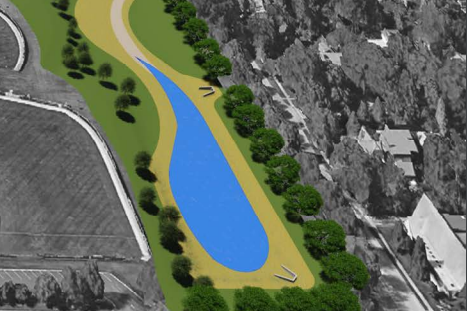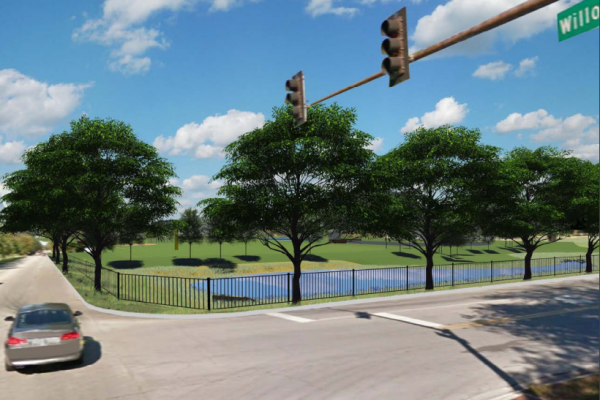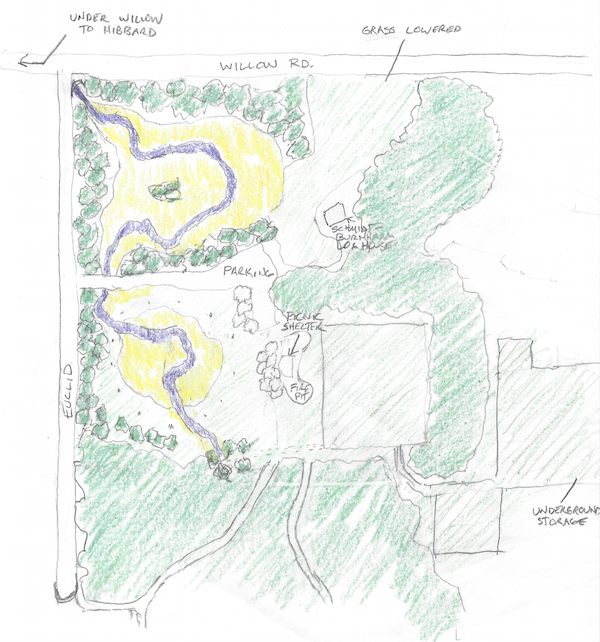Forest Preserve
Forest Preserve South of Landfill
60-100 Ac-Ft of wet or wetland storage.
Pros:
- Big space
- Current route for all runoff
- Adjacent to River for easy drainage
- Big & centrally located enough to be used for both tree street & south Winnetka drainage
Cons:
- Significant tree cover
- Adjacent to homes on Hibbard
Forest Preserve West of Public Works Building
20-35 Ac-Ft of storage.
Pros:
- Triangular space hidden behind Public Works building & landfill, Willow Rd. & River
- Safest location for deep, above-water storage
- Adjacent to River for easy drainage
- Higher ground elevation allows deeper storage
- Could be combined with enhancements to make entrance to Winnetka along Willow Rd. more attractive (see two photos below)
Cons:
- Farther west involve additional conveyance
- Higher ground might require some pumping
Forest Preserve West of Golf Course
20-30 Ac. Ft. of storage
Pros:
- Contiguous with Golf Course/New Trier Baseball Field storage
- Under-utilized, barely contiguous forest preserve property
- This development would improve usage of space
- Could link Forest Way bike path to Winnetka
Cons:
- Not quite adjacent to river
- Not big enough to store all of Winnetka’s water by itself
Forest Preserve – Skokie Lagoons
Using existing Skokie Lagoons to store 100-150 Ac. Ft. of stormwater run-off.
Pros:
- Using area already allotted to water
- Relatively convenient to tree streets, easy approach across tree streets
Cons:
- Strand: Modification of normal water levels to provide additional storage potential — adding level to dam, dredging bottom, or changing shoreline
- Strand: Modifications to existing ecology
- Strand: Outside agency and other community approvals (?) are necessary
- Requires significant new pumping facilities to convey into the lagoons
Forest Preserve Northfield
Pros:
- Adjacent to river for easy drainage
- Relatively close to south Winnetka, especially with Hill Rd. conveyance
Cons;
- Little too far South?
- A little too small to cover all of South Winnetka
Tree Streets
Skokie-Washburne Play Field
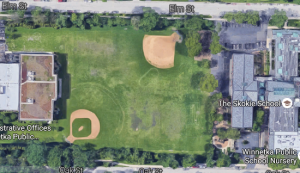 4-6 Ac-Ft of underground storage under play fields
4-6 Ac-Ft of underground storage under play fields
Pros:
- Right in middle of tree street area
- Land doesn’t cost anything
Cons:
- Challenge to work with school schedules
Nielsen Tennis Center
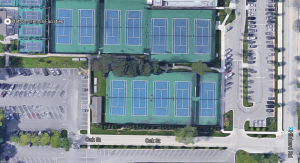 3-10 Ac-Ft of underground storage under tennis courts (~1 Ac), parking lots (~1.5 Ac)
3-10 Ac-Ft of underground storage under tennis courts (~1 Ac), parking lots (~1.5 Ac)
Pros:
- Central location adjacent to tree street area, Skokie/Washburne, golf course, Par 3, NT fields
- Land doesn’t cost anything. Don’t contain anything on top which can’t be replaced.
- Larger space than Skokie/Washburne
- $250k already budgeted towards digging out, replace tennis courts
Cons:
- Challenge to work with usage, donation schedule
Dwyer Park/Post Office Site
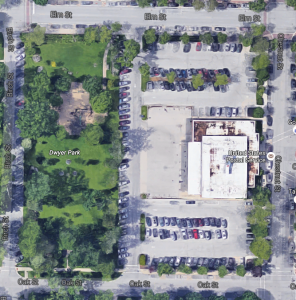 During larger events, stormwater from the west part of the Elm Street business district flows downhill to Provident eventually filling the Willow storm sewer and causing flooding in the south tree street area. We could reduce this flooding, and the pressure on the Metropolitan Water Reclamation District sanitary sewer trunk lines by capturing water from this area underneath grassy areas of Dwyer Park or under parking areas on the Post Office site. 4-15 Ac-Ft.
During larger events, stormwater from the west part of the Elm Street business district flows downhill to Provident eventually filling the Willow storm sewer and causing flooding in the south tree street area. We could reduce this flooding, and the pressure on the Metropolitan Water Reclamation District sanitary sewer trunk lines by capturing water from this area underneath grassy areas of Dwyer Park or under parking areas on the Post Office site. 4-15 Ac-Ft.
Pros:
- Both sites have considerable open space
- Both sites are slated to be completely rebuilt in the coming years, which would substantially reduce cost
- Elevation of this site is higher (~656 ft above sea level) than much of Winnetka, so more water could be stored underground
Duke Childs Field
12-16 Ac-Ft of above-ground wet or wetland storage where New Trier’s lacrosse/soccer fields are located.
Pros:
- Location can be reached from tree streets and/or south Winnetka
- Adjacent to South of Landfill long-term storage
Cons:
- NT loses fields unless fields are rebuilt on top of landfill (~$2.3M)
- Located adjacent to Hibbard residences
Private Properties on Pine/Hibbard
Pros:
- Large (2.5+ acres together) contiguous properties comparable in size to Skokie/Washburne playfield
- Adjacent to tree street flooding area
- Farther from school — could support deeper above-ground storage than most over Winnetka locations
- Could potentially replace some/all of Duke Child’s wetland
- Or, it could be used to save a place for tree street water. Quite a bit of water flows southward on Hibbard from areas as far north as Tower Rd. If we can take some of that water temporarily out of circulation after a big rain, there will be more room for water in the tree streets to move onward.
Cons:
- Relatively inexpensive on a cost/acre basis by Winnetka standards ($2.85M list), but land purchase makes it still that much more than Skokie/Washburne. More comparable to projected Duke Childs above-ground cost, since that involves terraforming landfill.
- If used as a replacement for Duke Childs, would require an extra block or two of piping (~$1-2M?) to get the water back to Duke Childs/Forest Preserve. If used for temporarily holding water from Northwest Winnetka, this is not a problem.
West Elm Street Park
Identified by Strand as a candidate for 8-12 Ac. Ft. of above ground wet or wetland storage.
Pros:
- Provides direct relief to tree streets
Cons:
- Would require removal of mature, high quality trees
- Would change character of park
- Located close to school & residential neighborhood, making deep water storage unpopular
Park District Maintenance Facility
Replace park district maintenance facility building with underground storage with turf field/parking lot similar to lacrosse field next to it.
Pros:
- Adjacent to tree street area
- Might be able to connect to area under LAX field
Cons:
- Only 2-3 Ac-Ft of storage
- Underground storage is more expensive
- Strand: “Not significantly effective”, meaning not enough storage to be worth the trouble?
In-Street Storage
It’s better to have water in streets than in houses. And, often one foot of water on two blocks is better than two feet of water on one block. We could flatten out the high spots in streets (for instance, around Locust & Rosewood) and allow the water to spread out better. This would reduce the depth in the deepest spots, and could make it cheaper and easier to drain one area with pumps, instead of several areas separated by hills. Lowering a part of the street near Hibbard would allow us to begin pumping earlier.
Similarly, holding back more of the water “upstream” of the problem areas could buy us more time to drain the downstream water and avoid the worst problems.
Grassy Storage
It’s better to have water in fields than on streets. Using portable pumps, Winnetka could pump water from the tree street areas into park district fields on the other side of Hibbard, and then pump it back into the storm sewer when the water in the streets has drained down.
South Winnetka
Crow Island Park North
12-25 Ac-Ft
- Above or underground wet/wetland storage
Pros:
- Located near south Winnetka flooded areas
- Already contains a wetland
- Contains almost unused Indian tree circle
Cons:
- Park shelter/fire pit are popular amenities, so it would be best not to use this part
- Winnetka Historical Society has 100 year lease on house location
- Just added Indian tree circle, might need to spade out and relocate.
- Located close to school & residential neighborhood, making deep water storage unpopular
Crow Island Park South
Strand identified this for as much as 20-35 Ac-Ft above-ground wet/wetland storage
Pros:
- Large space which doesn’t generate Park District revenue
- Conveniently located between south Winnetka flooded areas and Forest Preserve Site
Cons:
- Requires removal of mature, high-quality trees
- Would change character of park
- Located close to school & residential neighborhood, making deep water storage unpopular
- Strong resistance from residents who live nearby
- Challenges with most ideal conveyance Sunset Rd. due to private land-owners on both ends
Skokie Ditch
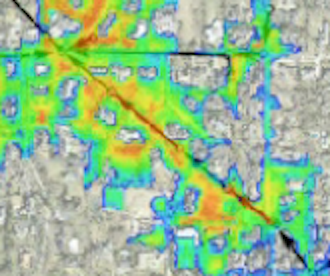 This 150-year-old bit of stormwater engineering is one of the first areas to flood in any storm, and eventually some of this water runs toward White Oak Lane and Dewindt, exacerbating flooding there. Dredging and improving the Skokie Ditch would help it store more water. If Winnetka helped those property owners adjoining the ditch terraform the large grassy areas around it, the homes there would be much safer from floods, and the area could store much more water (leading to improvements in other parts of south Winnetka) with no long-term consequences, provided the water were drained quickly. Turning the “Ditch” into a wetland could provide some green benefits.
This 150-year-old bit of stormwater engineering is one of the first areas to flood in any storm, and eventually some of this water runs toward White Oak Lane and Dewindt, exacerbating flooding there. Dredging and improving the Skokie Ditch would help it store more water. If Winnetka helped those property owners adjoining the ditch terraform the large grassy areas around it, the homes there would be much safer from floods, and the area could store much more water (leading to improvements in other parts of south Winnetka) with no long-term consequences, provided the water were drained quickly. Turning the “Ditch” into a wetland could provide some green benefits.
Pros:
- Winnetka has rights to the ditch itself
- There is a fair amount of open space around the ditch which could add significant capacity at a low price.
- Making the ditch a wetland would make it more natural than the current situation, and clean the water.
- Keeping water which falls here in the neighborhood is better for plants & animals.
Cons:
- Area around the Ditch is privately owned, so project would require agreement with neighbors.
Indian Hill Golf Course
4-6 Ac-Ft of above ground wet or wetland storage
Pros:
- Adjacent to SE-most flooded areas
- Water worked into existing course would make course more interesting, challenging
- Reduce lost profits due to storms
- Reduce water flowing back to Winnetka during some storms
Cons:
- Somewhat limited storage space [Get details from Strand]
Faith, Hope & Charity
Underground or surface storage offered by Faith, Hope & Charity. Initially, I believed that this area wasn’t likely to be helpful because it was not on a line between the worst flooded areas and the forest preserve, and a couple of blocks of pipe would be necessary to move the water. Having rewatched the stormwater modeling animation from the January 2016 Open House again, I’ve changed my mind. Enough water ran right by the site from Ridge & Forest St. towards the flooded areas around the Skokie Ditch that holding it back at Faith Hope might be more effective that I’d thought.
Pros:
- Located relatively close to SE-most area
- No cost
- Water runs right by this location
Cons:
- Strand: “Not significantly effective”… Too small? Cost of piping?
